Awards and decorations of Nazi Germany were military, political, and civilian decorations that were bestowed between 1923 and 1945, first by the Nazi Party and later the state of Nazi Germany.
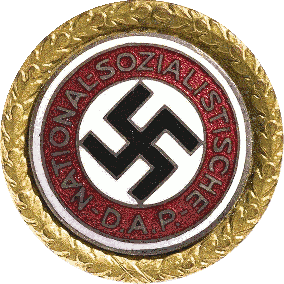
The Golden Party Badge was an award authorised by Adolf Hitler in a decree in October 1933. It was a special award given to all Nazi Party members who had, as of 9 November 1933, registered numbers from 1 to 100,000 and had unbroken Party membership. The recipient's party number was inscribed on the reverse of the badge. Only 20,487 men and 1,795 women were awarded the badge on these terms.
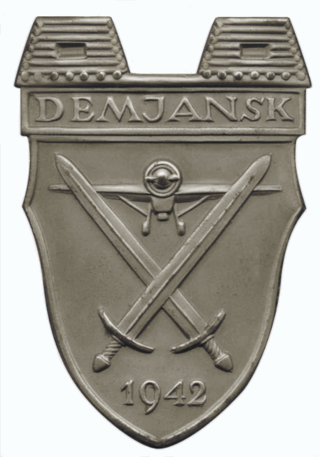
Demyansk Shield was a World War II German military decoration awarded to Wehrmacht personnel who fought in the Demyansk pocket on the Eastern Front in the early months of 1942. The pocket of German troops had been encircled and cut off by the Red Army around Demyansk (Demjansk), south of Leningrad, and was successfully defended with the aid of an airbridge. The shield was instituted on 25 April 1943 by Adolf Hitler and was not bestowed after 1 July 1944.

The Kuban Shield was a World War II military decoration of Nazi Germany. It was awarded to Wehrmacht forces who fought at the Kuban bridgehead in the Soviet Union from February 1943 until it was abandoned in October 1943. The award was instituted on 21 September 1943.

The Narvik Shield was a World War II German military decoration awarded to all German forces that took part in the battles of Narvik between 9 April and 8 June 1940. It was instituted on 19 August 1940 by Adolf Hitler. The Oberkommando der Wehrmacht (OKW) published the order the same day. It was bestowed by General Eduard Dietl, the commander of Army Group Narvik.
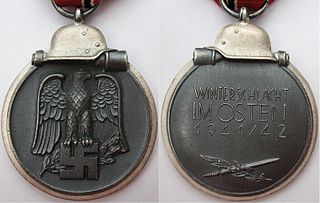
The Eastern Medal, officially the Winter Battle in the East 1941–42 Medal, was a military award of the Wehrmacht which was created by ordinance of Adolf Hitler on 26 May 1942.

Political decorations of the Nazi Party were medals and awards issued by the National Socialist German Workers Party (NSDAP) between 1920 and 1945. Political awards were authorised for wear on any paramilitary uniform of Nazi Germany, as well as civilian attire, but were generally discouraged on Wehrmacht military uniforms. The Waffen-SS freely wore both political awards and military decorations on their uniforms.

The Honour Cross of the World War 1914/1918, commonly referred to as the Hindenburg Cross or the German WWI Service Cross, was established by Field Marshal Paul von Hindenburg, President of the German Weimar Republic, by an order dated 13 July 1934, to commemorate service of the German people during the First World War. This was Germany's first official service medal for soldiers of Imperial Germany who had taken part in the war, and where they had since died it was also awarded to their surviving next-of-kin. Shortly after its issuance, the government of Nazi Germany declared the award as the only official service decoration of the First World War and further forbade the continued wearing of most German Free Corps awards on any military or paramilitary uniform of a state or Nazi Party organization.
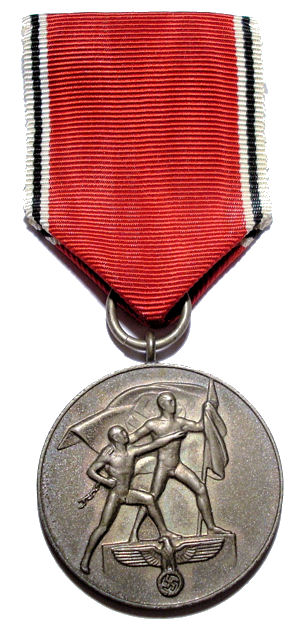
The Anschluss Commemorative Medal was a decoration of Nazi Germany awarded during the interwar period, and the first in a series of Occupation Medals.

The Return of Memel Commemorative Medal was a decoration of Nazi Germany awarded during the interwar period, the last in a series of Occupation Medals.
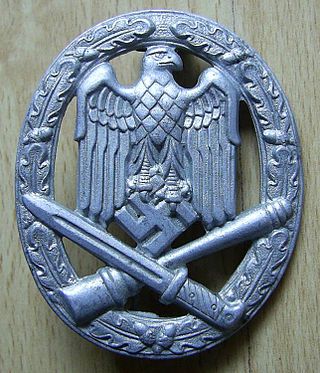
The General Assault Badge was a military decoration awarded during World War II to personnel of the German Army, Waffen-SS and Ordnungspolizei who supported an infantry attack but were not part of specific infantry units and therefore did not qualify for the Infantry Assault Badge. It was instituted by General Walther von Brauchitsch on 1 June 1940.

The Crimea Shield was a World War II German military decoration. It was awarded to military personnel under the command of Field Marshal von Manstein, including supporting naval and air force units, who fought against Soviet Red Army forces between 21 September 1941 and 4 July 1942 and who captured the Crimea region. It was instituted on 25 July 1942. It was the most widely distributed of the various German campaign shields, with approximately 250,000 awarded.
The German Occupation Medals were a series of awards, also known as the "Flower War medals", created to commemorate the successive annexations by Nazi Germany of neighbouring countries and regions with large ethnic German populations. These comprised Austria, the Sudetenland and Memel. The occupation of the remainder of western Czechoslovakia was marked by the 'Prague Bar', worn on the ribbon of the Sudetenland Medal.

The West Wall Medal was a decoration of Nazi Germany. It was instituted on 2 August 1939 and was given to those who designed and built the fortifications on Germany's western borders, known as the Westwall or, in English, the Siegfried Line, between 15 June 1938 to 31 March 1939. On 13 November 1939 eligibility was extended to include servicemen of the Wehrmacht who served on the Westwall for at least ten weeks. In all 622,064 medals were awarded until 31 January 1941, when awards of the medal ceased.
The Honour Roll Clasp was a decoration of Nazi Germany during World War II. There were different versions for the Army (Heer), Air Force (Luftwaffe) and Navy (Kriegsmarine).
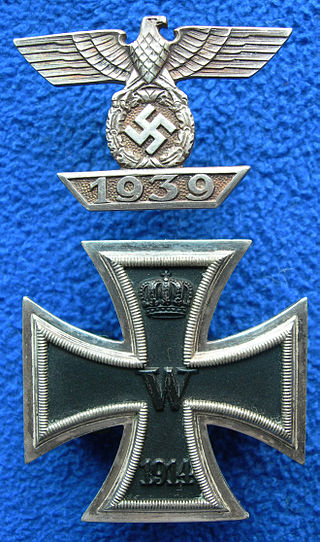
The Clasp to the Iron Cross was a white metal medal clasp displayed on the uniforms of German Wehrmacht personnel who had been awarded the Iron Cross in World War I, and who again qualified for the decoration in World War II.
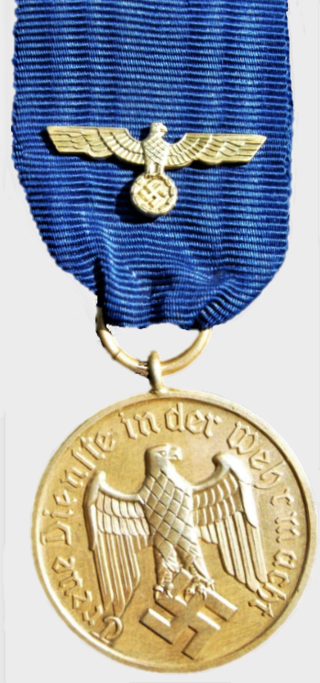
The Wehrmacht Long Service Award was a military service decoration of Nazi Germany issued for satisfactory completion of a number of years in military service.
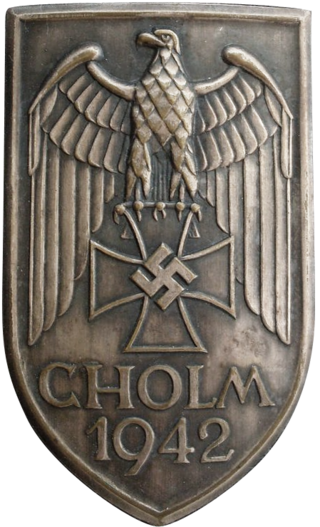
The Cholm Shield was a World War II German military decoration awarded to those who fought in the Cholm Pocket on the Eastern Front between 21 January and 5 May 1942. It was instituted on 1 July 1942 and is the rarest of the German combat shields, with approximately 5,500 recipients. Awards ceased to be bestowed on 1 April 1943.
Campaign shields, also known as campaign arm shields, were badges of differing design awarded to members of the German Wehrmacht for participation in specific battles or campaigns during World War II. Each shield was worn on the left upper arm of the uniform jacket. If a recipient received more than one shield, the earlier was worn above any later awards.

The Crete Cuff Title, or Crete Cuff Band, was a World War II German military decoration awarded to Wehrmacht servicemen who took part in the battle of Crete between 20 and 27 May 1941.















